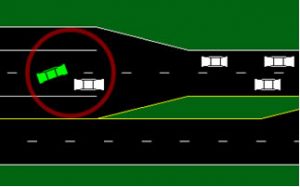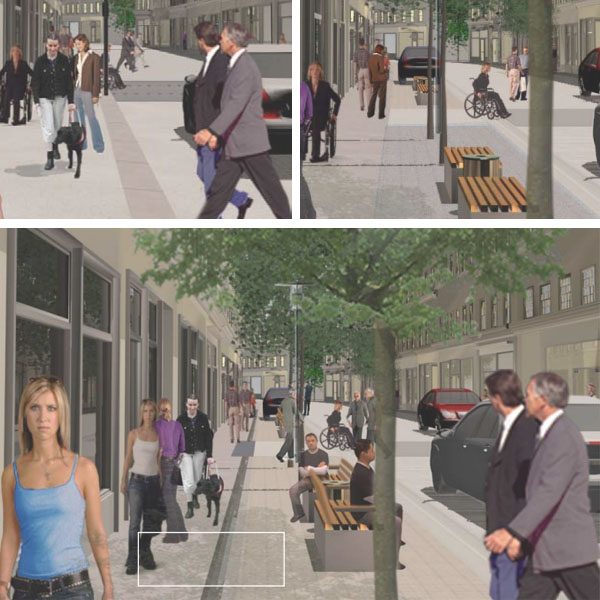It seems counterintuitive, but there’s evidence that getting rid of signals, signs and barriers might actually make streets a lot safer. Towns all over Europe are starting to experiment with streets where cars, buses, bikes and pedestrians can travel freely in the same space. 99% Invisible teamed up with Vox to bring you this video story on how “shared space” approaches are challenging road design conventions:
There’s a spot in Google street view where you can witness a town undergoing this exact kind of transformation. In Poynton, England there used to be a mess of signs and lights, a few small sidewalks and some haphazard guardrails to keep pedestrians safe.
A few years ago, all of these were removed. The town spent four million pounds to expand sidewalk space and strip the city center of traditional demarcations. Now, the only marker left is this little sign denoting the “Poynton Shared Space Village.”
The concept is that the absence of separation will make everyone more cautious — so commuters slow down, make eye contact, and negotiate. And because cars don’t spend time waiting at traffic lights, it takes less time on average for them to get through the crossing.
Even when cyclists and pedestrians are absent cars drive slowly due to a something called “edge friction.” It’s the idea that nearby vertical elements in a driver’s peripheral vision (like trees or lamps) create a visual cue for how fast they’re going. On a highway, those are often totally absent, so the sidelines blur. In a shared space, those lines play an important mental trick to slow down drivers.
In theory, shared spaces work well for pedestrians, allowing them to follow their desired path while walking. Instead of being limited to a strict path, they can walk exactly in the direction they want to go. In practice, that doesn’t always seem to be the case — often, people will still walk where they would expect to see crosswalks. And those pedestrians frequently report that they prefer things the way they used to be — but the “way things used to be” is relative.
If you look at old footage of city streets in the early 1900s (or listen to the episode above), cars mixed freely with pedestrians, bicyclists, and streetcars. Vehicles couldn’t go very fast back then, so there wasn’t a huge concern about separating them from walkers and bike riders.
 With plenty of city streets, that’s still the case without any intentional urban planning. But the big question is whether these deliberately stripped-down designs actually make people safer. It seems that in many cases, they do — we know that the number of accidents drops after shared spaces are installed. We also know that shared spaces are more free-flowing based on analysis of “traffic conflicts” (where someone makes an evasive maneuver to avoid an accident). But that doesn’t mean these designs work for everyone.
With plenty of city streets, that’s still the case without any intentional urban planning. But the big question is whether these deliberately stripped-down designs actually make people safer. It seems that in many cases, they do — we know that the number of accidents drops after shared spaces are installed. We also know that shared spaces are more free-flowing based on analysis of “traffic conflicts” (where someone makes an evasive maneuver to avoid an accident). But that doesn’t mean these designs work for everyone.
From the beginning, shared space designs have been under fire for providing insufficient protections for disabled pedestrians, especially the visually impaired. A 2015 House of Lords report called for a temporary ban on shared space designs. And in August of 2016, a select committee of the House of Commons launched an inquiry into the accessibility of such environments. Their final report in April of 2017 asked the government to put all shared space schemes on hold until they improved the process of consulting disabled communities.
Preliminary designs by groups like the Danish Building Research Institute hint at what a balanced approach might look like. They include both the mixed traffic of shared spaces but also raised street textures and button-activated crosswalks for pedestrians with disabilities.
Shared spaces can be effective, but for this kind of plan to function well across communities, a lot more research is needed to determine what will work in different places and serve the needs of all the people sharing the streets. This will also require a radical rethinking of how we move through our daily lives, raising questions about signs and infrastructure we see everywhere but take for granted — and it will mean rewriting the rules of what a city can look like.





Comments (6)
Share
I find these unsigned spaces much more stressful, both as a driver and a pedestrian. Yes everyone slows down as they feel anxious, but conventions that cars won’t enter pavements and pedestrians amble down the road benefit both parties.
Compare a spiral laned roundabout with the Arch de Triomphe
One reason I feel like there are so few pedestrian accidents in NYC is that it is one of the few cities where the pedestrians feel like they own the road. They cross streets on a whim and rarely wait for the light cats are physically in the space already. Because of this drivers are much more cautious driving in these congested areas and accidents on a per capita basis are very low.
Shared Space definitely has its place in among others in the road design toolbox. But the only times I have ever seen them be effective is when traffic volumes are extremely low, as in <100 cars an hour. This is when drivers actually respond to the lack of signs and specific markings.
In the UK, shared space has been used mainly without serious attempts to lower traffic volume. So car drivers see other cars in large numbers, feel like they still ‘own’ the space and therefore do not meaningfully adjust their behaviour to accommodate people walking a cycling.
Ultimately, the way to make shared space suceed is down to other less fashionable factors such as modal filtering and not allowing rat running.
Bikers or cyclists?
Road signs suck in many places in Europe, but they generally don’t suck TOO badly in the US, where there are Federal standards that are, for the most part, pretty reasonable.
I’ve driven in the US, Europe, Australia, the U.K., Japan, Hong Kong, and China, so I’ve got some experience with both good and bad signage and road construction. I’ve seen good designs, bad designs, and what the frood were they thinking designs. Another point of note in my humble opinion is that what SIDE of the road you drive on makes effectively no difference at all.
If you tried the “shared space” model in Texas, traffic and pedestrian deaths would easily triple. In any case, driver stress levels and road rage would increase dramatically.
Oh God NO!!! No No No! I live in Poynton! The traffic is backed up just as much as it ever was when we had the traffic lights. If you are visibly impaired you cannot cross. When we checked with the Dutch designers they said it only would work if we had a bypass (we still don’t) and they then said there was better schemes than shared space. The council only did it to spend money because the next village, Handford, got a cash grant to do up their little shopping centre.
The only single good thing was we got a new piece of music composed. Even the way they did it. Months to rip up the roads to lay down blocks to raise the road level with the pavement. Pouring extra tarmac was too cheap and quick to do.